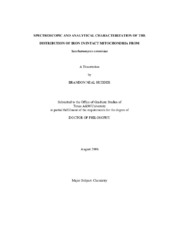| dc.description.abstract | Electron paramagnetic resonance (EPR) and Mössbauer spectroscopy were used to examine the distribution of iron in mitochondria from Saccharomyces cerevisiae. These organelles were packed into EPR and Mössbauer cuvettes, affording spectra with unprecedented signal/noise ratios. EPR spectra of as-isolated intact mitochondria exhibited fourteen distinct signals, some of which were assigned according to previously reported g-values obtained using isolated proteins. Signals from adventitious manganese (II) and iron (III) were largely removed when mitochondria were isolated in buffers supplemented with the metal chelators EDTA or EGTA. Signals were simulated and intensities were quantified to afford spin concentrations and estimates of the concentration of EPR-active species in mitochondria. The effects of treating samples with chemical modifiers were examined. Packed samples were analyzed for protein and metal content, affording averaged values of 50 mg/mL [protein], 590 µM [Fe], 340 µM [Cu], and 17 µM [Mn]. 57Fe-enriched intact mitochondria isolated in the presence of metal chelators exhibited Mössbauer spectra dominated by three components. Approximately 60% of the 57Fe in the sample gave rise to a quadrupole doublet, most of which was diamagnetic. The parameters of this doublet are typical of S = 0 [4Fe-4S]2+ clusters and S = 0 ferrous heme groups. Spectra of samples reduced with dithionite, pH 8.5, suggested that at least half of this doublet arose from [4Fe-4S]2+ clusters. The second major component exhibited in the Mössbauer spectra arose from high-spin ferrous ions (10%-30%). The third major component (15%) came from iron exhibiting magnetic hyperfine interactions and is likely reflected in the Fe-containing species observed by EPR. The results presented here suggest that mitochondria contain ~ 600 µM of Fe overall, ~ 200 – 400 µM organized as [4Fe-4S]2+ clusters, with about 25 µM due to the [4Fe-4S]2+ cluster of aconitase. Approximately 60 µM – 200 µM of the Fe in mitochondria is high-spin ferrous ions, ~ 40 µM as the Rieske S = 1/2 [2Fe-2S]+ cluster of cytochrome bc1, and ~20 µM as the S = 1/2 [2Fe-2S]+ cluster of succinate dehydrogenase. The high-spin ferric hemes of the a3:CuB site of cytochrome oxidase and cytochrome c peroxidase each account for ~ 4 µM of Fe. | en |


